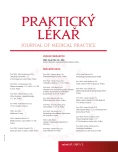Health status of foreigners registered at general practitioners in Ostrava
Authors:
H. Tomášková 1,2; J. Vavrošová 1; S. Petříková 1
Authors‘ workplace:
Ostravská Univerzita v Ostravě
Lékařská fakulta
Ústav epidemiologie a ochrany veřejného zdraví
Vedoucí: prof. MUDr. Vladimír Janout, CSc.
1; Zdravotní ústav se sídlem v Ostravě
Centrum zdravotních služeb
Vedoucí: MUDr. Anna Šplíchalová, Ph. D.
2
Published in:
Prakt. Lék. 2017; 97(2): 67-72
Category:
Of different specialties
Overview
Introduction:
Since 1989, the number of foreigners living in the Czech Republic has multiplied and the foreigners represent 4% of inhabitants in the Czech Republic. The objective of the study was to determine the way how the foreigners use health care provided by GPs in Ostrava, and to determine their health status detected on the basis of GPs‘ medical records.
Methods:
The survey was based on information from the questionnaires filled in by general practitioners. A total of 51 general practitioners participated in the survey in Ostrava and the data of 386 foreigners was obtained. The queste statistionnaire included 27 questions, concerning demographic data, communicative ability, life style and health status. Data analyses were performed using the descriptivics, χ>2-test, logistic regression and the method of decision trees. Statistical tests were evaluated at a significance level of 5%. Data analyses were carried out using the SW Stata. v. 13.
Results:
In terms of the distribution of all 386 respondents, up to 50% (193) of all foreigners were from Vietnam, followed by Slovaks 21% and Poles (7%). The health status of 39 % foreigners was identified as bad (they suffered from some kind of chronic illness or other serious illness). Health status was affected (after adjustment for age and sex) by ethnic group, the risk for Vietnamese was significantly higher compared with groups of Slovaks and Poles. Another risk factor was accounted for obesity. The regular participation in preventive examinations was observed in 49% of foreigners.
Conclusion:
Information was obtained only from 4% of the total number of foreigners residing in the region of Ostrava, which means that primary medical care is received only by a low percentage of foreigners. The cause can be “healthy immigrant effect” and/or the unavailability of health insurance.
KEYWORDS:
foreigners – general practitioners – health status – risk factors – preventive health examinations
Sources
1. Všeobecná zdravotní pojišťovna. Na preventivní prohlídky k praktikovi chodí méně než 40 % lidí [on-line]. VZP, 2015. Dostupné z: www.vzp.cz/o-nas/aktuality/analyza-vzp-na-preventivni-prohlidky-k-praktikovi-chodi-mene-nez-40-lidi [cit. 2016-11-16].
2. Český statistický úřad. Cizinci podle typu pobytu a státního občanství 2015 [online]. Dostupné z: www.czso.cz/csu/cizinci/cizinci-pocet-cizincu [cit. 2016-11-16].
3. Český statistický úřad. Cizinci v Moravskoslezském kraji 2015 [online]. Dostupné z: www.czso.cz/documents/11288/40159435/cizinci16.pdf/7f0efa42-4f0d-455a-bac8-b91a35632f65?version=1.1 [cit. 2016-11-16].
4. Český statistický úřad. Cizinci: Počet cizinců 2015 [online]. Dostupné z: www.czso.cz/csu/cizinci/cizinci-pocet-cizincu [cit. 2016-11-16].
5. Cutled DM, Lleras-Muney A. National Poverty Center. Education and Health 2007 [online]. Dostupné z: www.npc.umich.edu/publications/policy_briefs/brief9/ [cit. 2016-11-16].
6. Ústav zdravotnických informací a statistiky ČR. Čerpání zdravotní péče cizinci 2015. [online]. Dostupné z: www.uzis.cz/category/tematicke-rady/ekonomika-financni-analyzy/cerpani-zdravotni-pece-cizinci [cit. 2016-11-16].
7. Doty M. Hispanic patients’ double burden: lack of health insurance and limited English [online]. Dostupné z: www.commonwealthfund.org/publications/fund-reports/2003/feb/hispanic-patients-double-burden--lack-of-health-insurance-and-limited-english
8. Feinstein L, Sabates R, Anderson TM, et al. What are the effects of education on health? [online]. Copenhagen: OECD, 2006. Dostupné z: www1.oecd.org/edu/innovation-education/37425753.pdf [cit. 2016-11-16].
9. World Health Organization. Global Health Observatory data repository. Dostupné z: apps.who.int/gho/data/node.main.A900A?lang=en [cit. 2016-11-16].
10. Hnilicová H. Důvody pro zahrnutí migrantů ze třetích zemí do veřejného zdravotního pojištění. Prakt. Lék. 2016; 96(2): 96–99.
11. Jasso G, Massey DS, Rosenzweig MR, Smith J. Immigrant health: selectivity and acculturation. In: Anderson NB, Bulatao RA, Cohen B (eds.). Critical perspectives on racial and ethnic differences in health in late life [online]. Dostupné z: www.ncbi.nlm.nih.gov/books/NBK25533/ [cit. 2016-11-16].
12. McDonald J, Kennedy T. Insights into the healthy immigrant effect: health status and health service use of immigrants to Canada. Soc Sci Med 2004; 59: 1613–1627. Dostupné z: www.sciencedirect.com/science/article/pii/S0277953604000516 [cit. 2016-11-16].
13. World Health Organization. Obesity and overweight. Fact Sheet. Updated June 2016. Dostupné z: www.who.int/mediacentre/factsheets/fs311/en/ [cit. 2016-11-16].
14. Wilson E, Chen AH, Grumbach K, et al. Effects of limited English proficiency and physician language on health care comprehension. J Gen Intern Med 2005; 20(9): 800–806. Dostupné též z: www.ncbi.nlm.nih.gov/pmc/articles/PMC1490205/ [cit. 2016-11-16].
15. Ústav zdravotnických informací a statistiky ČR. Zdravotnická ročenka České republiky 2013 [online]. Dostupné z: www.uzis.cz/publikace/zdravotnicka-rocenka-ceske-republiky-2013 [cit. 2016-11-16].
Labels
General practitioner for children and adolescents General practitioner for adultsArticle was published in
General Practitioner

2017 Issue 2
Most read in this issue
- Firearm license – a summary of changes in the assessment of medical fitness of applicants
- Reasons for hospitalization in patients diagnosed from the schizophrenia, schizotypal and delusional disorders
- The practical application of clinical criteria for the recognition of the disease of the lumbar spine from overloading as an occupational disease
- Optical coherence tomography application in diagnostics and monitoring of idiopathic intracranial hypertension patients
